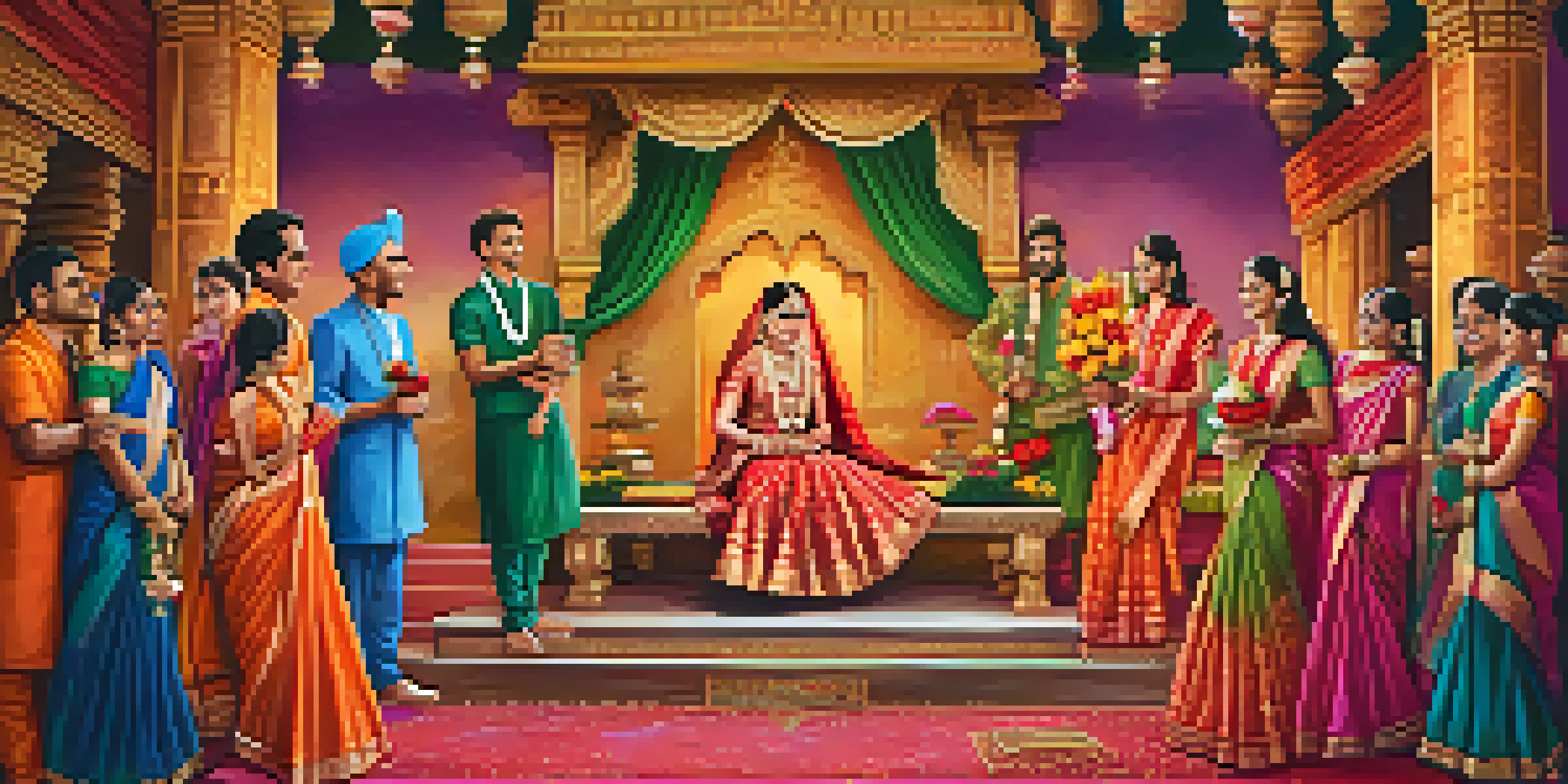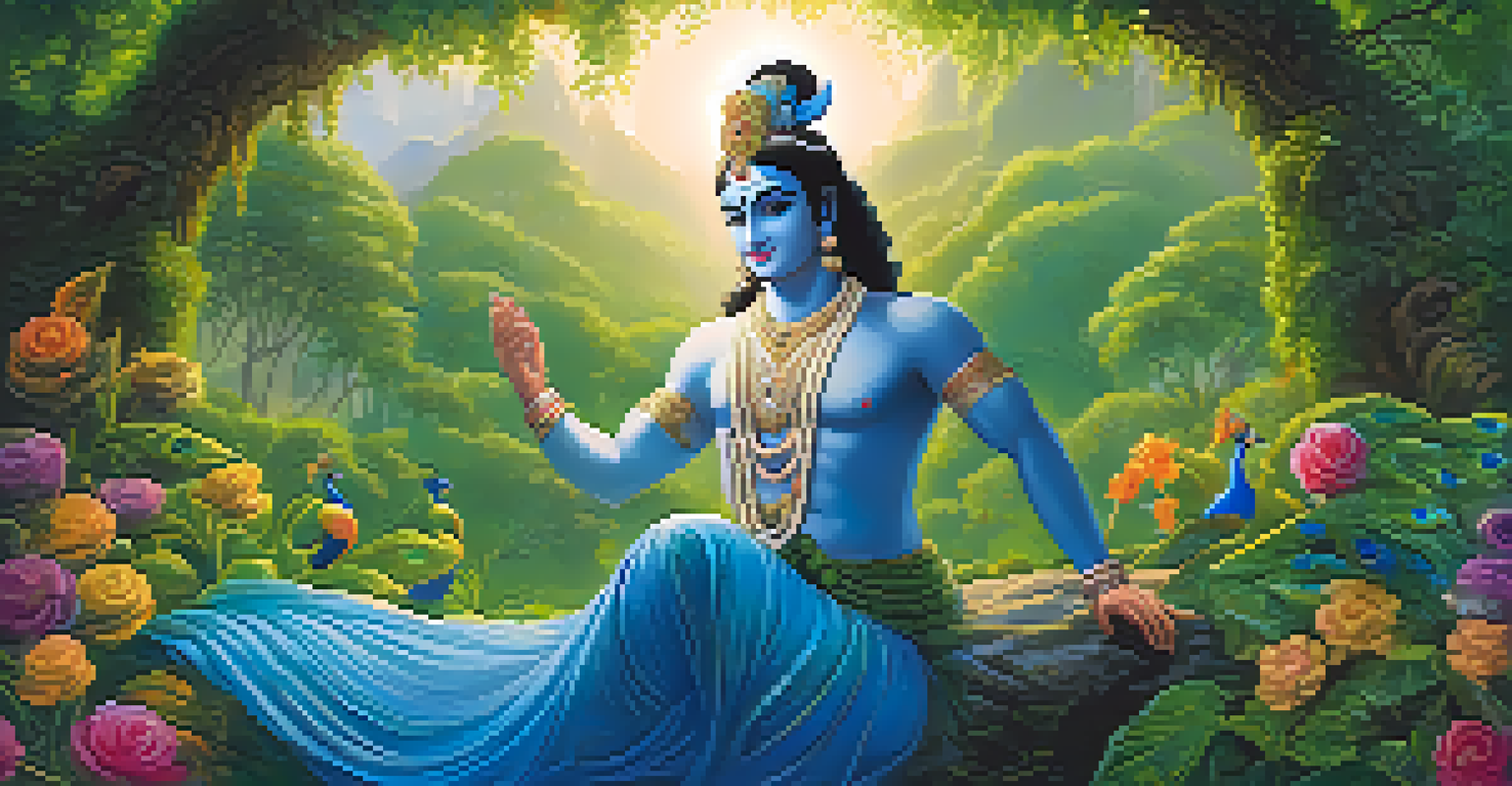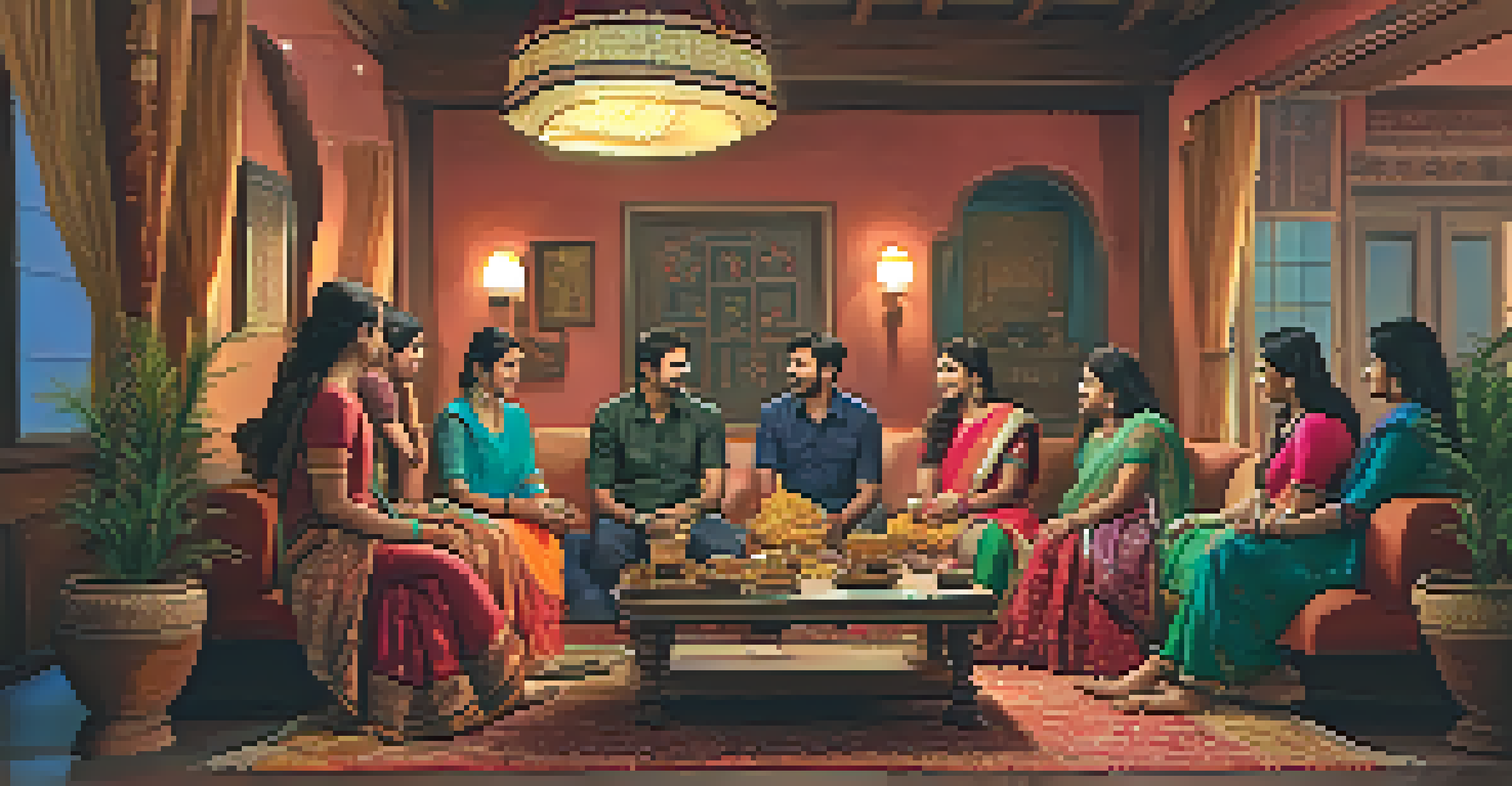Hinduism in Cinema: Myths, Rituals, and Cultural Insights

The Role of Myths in Hindu Cinema
Myths play a crucial role in Hindu cinema, often serving as the backbone of many narratives. Films frequently adapt stories from ancient texts like the Ramayana and Mahabharata, bringing these tales to life for modern audiences. By illustrating the heroic journeys of deities and legendary figures, filmmakers create a rich tapestry that resonates with viewers. This connection to myth not only entertains but also educates audiences about key cultural values and moral lessons.
Cinema is a mirror of society, reflecting its values, challenges, and transformations.
For instance, the film 'Baahubali' draws heavily on mythological themes, showcasing the epic battles and moral dilemmas faced by its characters. Such representations allow viewers to engage with the moral complexities of dharma, or duty, a central tenet in Hindu philosophy. The visual spectacle of these myths on screen captures the imagination, making ancient stories relevant and accessible to everyone.
Moreover, these films often spark conversations about the underlying philosophies and ethics presented in the myths. As audiences witness the struggles of these legendary figures, they may reflect on their own lives and the choices they face. This interplay between myth and personal experience elevates the cinematic experience from mere entertainment to a profound exploration of human existence.
Rituals Depicted in Indian Films
Rituals are an integral part of Hindu culture, and their portrayal in cinema adds depth to storytelling. From weddings to religious ceremonies, films often showcase these traditions, offering viewers a glimpse into the spiritual fabric of Hindu life. This not only helps preserve these practices but also introduces them to those unfamiliar with Hindu customs, bridging cultural gaps.

For example, the vibrant depiction of a traditional Hindu wedding in films like 'Vivah' highlights various rituals, such as the Saptapadi, where the couple takes seven steps together. These moments are filled with emotion and symbolism, reflecting the sacredness of the union. Such portrayals resonate deeply with audiences, evoking nostalgia and reverence for their own cultural experiences.
Myths Enhance Hindu Cinema Narratives
Hindu cinema often adapts ancient myths to engage audiences with moral lessons and cultural values.
Additionally, the representation of rituals can serve as a commentary on contemporary issues. Films might juxtapose traditional practices with modern challenges, prompting discussions about the evolving nature of culture. By doing so, filmmakers encourage viewers to reflect on their beliefs and the significance of rituals in a rapidly changing world.
Symbolism of Deities in Film
Deities play a pivotal role in Hindu cinema, often symbolizing various human traits and moral lessons. Filmmakers utilize these divine figures to encapsulate complex ideas, making them relatable to diverse audiences. This symbolism allows viewers to connect with the characters on a deeper level, as they embody the virtues and vices inherent in human nature.
Film is a powerful medium for storytelling; it can inspire change and offer insights into the complexities of culture.
Take, for instance, the character of Lord Krishna in films like 'Karan Arjun', where he represents the ideals of righteousness and cunning. His actions and teachings provide a moral compass for the protagonists as they navigate their challenges. By invoking such revered figures, filmmakers not only enhance their narratives but also instill a sense of guidance and inspiration.
Furthermore, the visual representation of deities, with their distinct attributes and colors, adds a rich layer of meaning to the cinematic experience. The vibrant imagery captures the audience's attention and reinforces the cultural significance of these figures. Through this artistic expression, filmmakers celebrate the spiritual heritage of Hinduism, making it accessible and meaningful in a contemporary context.
Cultural Insights Through Storytelling
Hindu cinema serves as a mirror to society, reflecting its values, challenges, and transformations. Through storytelling, filmmakers highlight various aspects of life, from family dynamics to social issues, providing insights into the cultural landscape. This portrayal helps audiences understand their own identities and the world around them.
For example, films like 'Paa' delve into the complexities of family relationships and societal acceptance, weaving in elements of Hindu values like respect and compassion. By addressing these themes, filmmakers create a dialogue about the challenges faced by individuals and families in contemporary society. This connection fosters empathy and understanding among diverse groups.
Rituals Bridge Cultural Understanding
The portrayal of Hindu rituals in films offers insights into traditions, preserving them while introducing them to new audiences.
Additionally, cinema can challenge stereotypes and promote inclusivity, showcasing the diversity within Hindu culture. By depicting a range of characters and experiences, filmmakers enrich the narrative, encouraging a broader appreciation for the complexity of human experiences. This cultural exploration invites audiences to reflect on their own beliefs and assumptions, ultimately fostering greater understanding and acceptance.
The Aesthetic of Spirituality in Film
The aesthetic representation of spirituality in Hindu cinema is often visually stunning, employing vibrant colors, intricate costumes, and elaborate sets. These elements create an immersive experience for viewers, drawing them into the spiritual world depicted on screen. The visual storytelling enhances the emotional impact of the narrative, making the spiritual journey feel tangible.
For instance, films like 'Devdas' utilize lavish visuals to depict the protagonist's struggle with love and loss, intertwining elements of spirituality and human emotion. This combination allows audiences to experience the depths of despair and redemption, reinforcing the notion that spirituality is intricately linked to our human experiences. The film's aesthetic serves as a bridge between the divine and the mortal.
Moreover, the use of music and dance in Hindu cinema further elevates the spiritual experience. Traditional songs and dances often accompany key moments, imbuing them with additional meaning and evoking deep emotions. This multisensory approach not only captivates viewers but also reinforces the idea that spirituality is a celebration of life in all its forms.
Global Influence of Hindu Cinema
Hindu cinema has transcended borders, captivating audiences worldwide and influencing global film industries. The unique storytelling techniques and rich cultural narratives resonate with people from diverse backgrounds. As a result, Hindu films often find a place in international film festivals, showcasing the beauty and complexity of Indian culture.
Take the film 'Lagaan', for example, which garnered international acclaim and showcased themes of resilience, community, and justice. Its success not only highlighted the artistry of Indian cinema but also introduced audiences to the cultural values inherent in Hinduism. This global recognition paves the way for cross-cultural exchanges and fosters a greater understanding of Hindu traditions.
Hindu Cinema Faces Misrepresentation
Challenges in accurately depicting Hindu culture in films can lead to stereotypes and misunderstandings, highlighting the need for sensitivity.
Furthermore, the influence of Hindu cinema can be seen in various genres, including action, romance, and drama, inspiring filmmakers across the world. Elements of storytelling, music, and dance from Hindu films have been integrated into global cinema, enriching the art form as a whole. This cultural exchange emphasizes the universal nature of storytelling and the shared human experiences that connect us all.
Challenges and Misrepresentations in Cinema
Despite the rich tapestry of Hindu culture, cinema often faces challenges related to misrepresentation and stereotypes. Some films may oversimplify complex traditions or present inaccurate portrayals of Hindu practices. These misrepresentations can perpetuate misunderstandings and contribute to cultural appropriation, making it crucial for filmmakers to approach their subjects with sensitivity and respect.
For instance, the portrayal of Hindu rituals in some mainstream films may lack the nuance required to convey their true significance. This can lead to misconceptions among audiences unfamiliar with the culture. Filmmakers have a responsibility to conduct thorough research and present a balanced view, ensuring that the beauty and depth of Hinduism are accurately represented.

Moreover, the challenge lies in balancing entertainment with authenticity. While films aim to captivate audiences, they must also honor the cultural and spiritual heritage they depict. By striving for accuracy and depth, filmmakers can contribute to a more informed and respectful understanding of Hinduism, fostering a greater appreciation for its richness and diversity.
The Future of Hinduism in Cinema
As society evolves, so too does the portrayal of Hinduism in cinema. New filmmakers are exploring innovative narratives that challenge traditional norms and reflect contemporary issues faced by the Hindu community. This evolution presents an opportunity to broaden the scope of storytelling and engage audiences in meaningful dialogues about faith, identity, and culture.
For example, films that tackle topics such as caste, gender equality, and environmental issues are gaining traction, reflecting the changing landscape of Hindu society. By addressing these subjects, filmmakers can engage younger audiences and encourage critical thinking about the values they hold. This shift represents a growing recognition of the need for diverse voices and perspectives in the cinematic space.
Ultimately, the future of Hinduism in cinema lies in its ability to adapt and resonate with new generations. By embracing innovation while honoring tradition, filmmakers can continue to celebrate the beauty of Hindu culture. This dynamic interplay between the past and present ensures that the narratives remain relevant, fostering a deeper understanding of Hinduism in an ever-changing world.